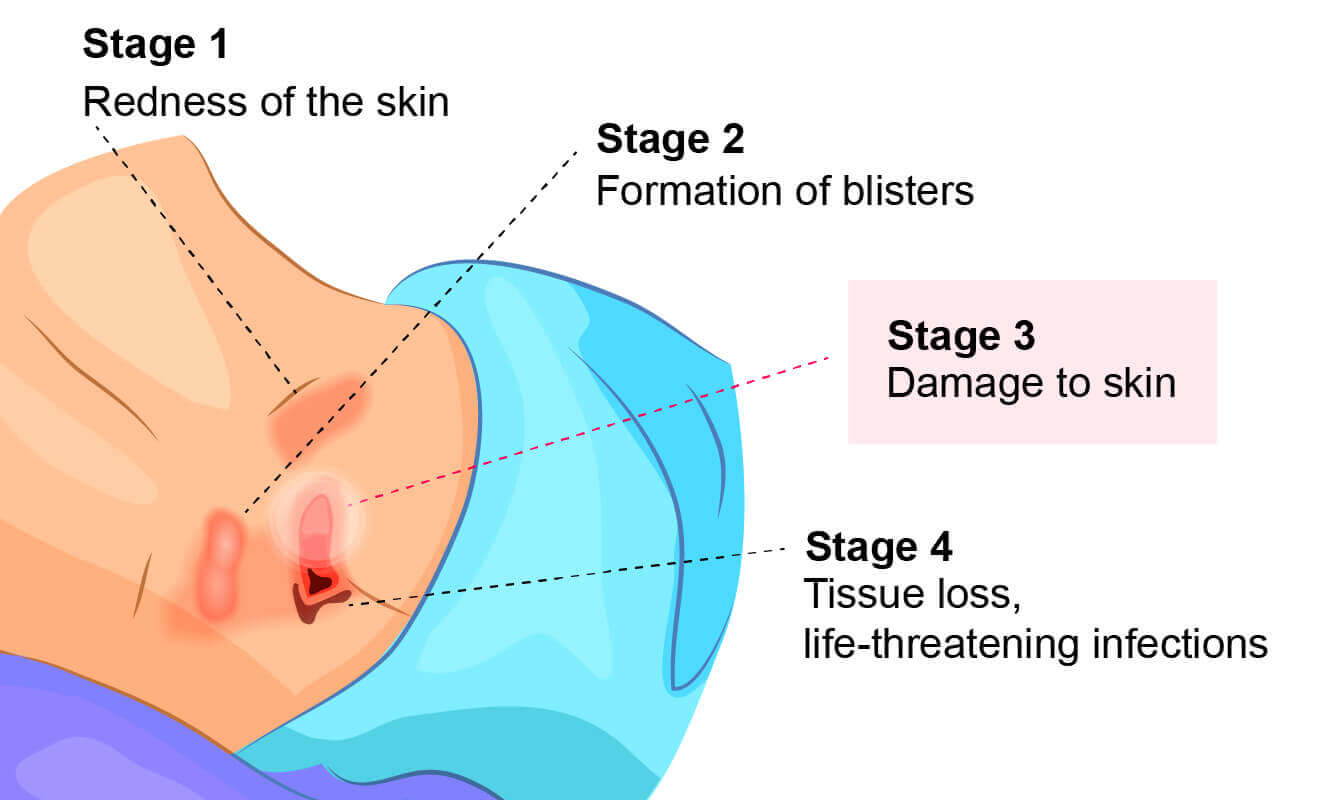Bedsore develops when blood supply to the skin is cut off for more than 2 to 3 hours. As the skin dries, bedsore first starts as a red, painful area, which eventually turns purple. If it is left untreated, the skin can break open and the area can become infected. Being bedridden, unconscious, unable to sense pain, or immobile increases the risk that bedsores will develop. The risk increases if the person is not turned, positioned correctly, or provided with proper nutrition and skincare. People with diabetes, circulation problems, and malnutrition are at higher risk.
Signs and symptoms:
Symptoms of a pressure sore include:
- Color changes: If discoloration does not disappear after removing the pressure for 10–30 minutes, this may indicate that a sore is forming.
- Texture changes: The area may feel hard or spongy and warm.
- Broken skin: There may be a shallow, open sore with fluid or pus in it. The wound may extend into the deeper layers of tissue.
- Infection: Signs include a change in color or sensation around the edge of the sore, the presence of more pus, green or black tissue around the sore, and a fever.
When to see a doctor?
If you notice warning signs of bedsore, change your position to relieve the pressure on the area. If you don't see improvement in 24 to 48 hours, contact your doctor. Seek immediate medical care if you show signs of infection, such as a fever, drainage from a sore, a sore that smells bad, or increased redness, warmth, or swelling around a sore.
see a doctor when you think you have symptoms of asthma and for its treatment and monitoring.
(بیڈسور (بستری زخم
بیڈسور اس وقت بنتا ہے جب جلد کو 2 سے 3 گھنٹے سے زیادہ وقت تک خون کی سپلائی بند ہوجاتی ہے۔ جیسے جیسے ہی جلد مردہ ہوتی ہے ، بیڈسور پہلےگلابی یا سرخ ، تکلیف دہ ہونا شروع ہوتا ہے اور بالآخر جامنی ہو جاتا ہے۔ اگر اس کا علاج نہ کیا جائے تو جلد میں زخم ہو سکتا ہے اور اس میں انفیکشن پھیل سکتا ہے۔ یہ عوامل بیڈ سور کے خطرے کو بڑھا سکتے ہیں: بستر پر لیٹے رہنا ، مریض کا بے ہوش ہونا ، درد کو محسوس کرنے سے قاصر ہونا جیسے کہ ذیابیطس میں ہوتا ہے ، یا غیر متحرک ہونا۔ خطرہ بہت حد تک۔کم ہو جاتا ہے اگر ایسے مریضوں کو بار بار کروٹ بدلی جائے ، صحیح پوزیشن میں رکھا جائے اور مناسب غذائیت اور جلد کی دیکھ بھال فراہم کی جائے۔ ذیابیطس ، خون کی گردش کے مسائل اور کم غذائیت والے مریضوں کو زیادہ خطرہ ہوتا ہے۔
نشانات و علامات:
بستری زخم کی علامات میں شامل ہیں:
جلد کا رنگ تبدیل ہونا: اگر 10 سے 30 منٹ تک دباؤ کو ہٹانے کے بعد رنگت غائب دوبارہ واپس نہیں آتی ، تو یہ اس بات کی نشاندہی کرسکتا ہے کہ زخم بن رہا ہے۔
- جلد کی بناوٹ میں تبدیلی: یہ حصہ سخت یا نرم اور گرم محسوس ہو سکتا ہے۔
- ٹوٹی ہوئی جلد: ایک کھلا زخم بن سکتا ہے جس میں پیپ ہو۔ زخم جلد کی گہری تہوں تک پھیل سکتا ہے۔
- انفیکشن: علامات میں زخم کے کنارے کے ارد گرد رنگ یا احساس میں تبدیلی ، پیپ کی موجودگی ، زخم کے گرد سبز یا سیاہ ٹشو اور بخار شامل ہیں۔
ڈاکٹر سے کب ملنا ہے۔
اگر آپ کو بیڈسور کے نشانات نظر آتے ہیں تو اس حصے پر دباؤ کو دور کرنے کے لیے مریض کی پوزیشن تبدیل کرتے رہیں۔ اگر آپ کو 24 سے 48 گھنٹوں میں بہتری نظر نہیں آتی ہے تو اپنے ڈاکٹر سے رابطہ کریں۔ اگر آپ کو انفیکشن کے آثار دکھتے ہیں ، جیسے کہ بخار ، زخم سے پیپ ، زخم سے بدبو آ رہی ہو ، یا زخم میں لالی ، گرمی یا سوزش میں اضافہ ہو تو فوری طبی امداد حاصل کریں۔
Doctors to consult (Dermatologist):
Dr. Areesha Shahzado, Dr. Obaidur Rehman, Dr Shamsa Kanwal, Dr. Wajiha Naqvi
Note: Click the Doctor's name to make an appointment.
Reference:
https://www.mayoclinic.org/diseases-conditions/bed-sores/symptoms-causes/syc-20355893
https://www.healthline.com/health/pressure-ulcer

